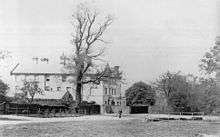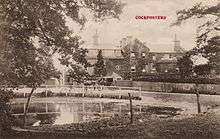Ludgrove Hall



Ludgrove Hall is a house in Games Road, Cockfosters, north London, on the edge of Monken Hadley Common. It was originally a private home but then became Ludgrove School and has now been converted to flats. Additional buildings have since been constructed in the grounds.
Background
The Hall was built on land that was originally part of the Ludgrove (or Ludgraves) estate[1] and it was known as Ludgrove Farm before 1422.[2] The land was transferred to the Crown in 1542[2] and it was later owned by Sir Roger Wilbraham who built almshouses in nearby Monken Hadley in 1612.[1] It was once known as the Blue House[3] and appears in that name on Francis Russell's 1776 map of Enfield Chase.[4]
The house
The current house dates from the 1830s and was the home of Francis Bevan until 1890 when Bevan moved to Trent Park following his father's death.[5]
From 1892 the house was Ludgrove School, a boys preparatory school, until the school moved to Wokingham in 1937.[6] The school was founded in 1892 by Arthur Dunn in north London. Dunn, a footballer, recruited a number of sportsmen to assist him as masters and was succeeded, on his premature death, by two England international football captains, G.O. Smith and William Oakley, who became joint headmasters. According to Nancy Clark, it was a "famous preparatory school for Eton" attended by young Royals and sons of the aristocracy.[7] Pupils at Ludgrove Hall included Osbert Sitwell, John Dunville VC, and Prince Alexander of Yugoslavia.[8] Ex-pupil Alistair Horne wrote an unflattering account of his time at the school in the 1930s in which he described "humbug, snobbery and rampant, unchecked bullying" which he thought was intended to toughen the boys up.[9]
The house was built for redevelopment in 1939 but no action was taken due to the Second World War. It was compulsorily purchased in 1950.[3] In the 1980s and 90s the building was used as accommodation and a conference centre for Middlesex Polytechnic, later Middlesex University.
Around 1999, the building was converted into apartments by St James Homes and detached houses built in the grounds.[10]
References
- 1 2 "Take a Tour of the Common" Monken Hadley Common. Retrieved 8 August 2015.
- 1 2 Monken Hadley Conservation Area Character Appraisal Statement Archived 2015-10-09 at the Wayback Machine. London Borough of Barnet, Barnet, 2007, pp. 39-41.
- 1 2 Taylor, Pamela, & Joanna Corden. (1994) Barnet, Edgware, Hadley and Totteridge: A pictorial history. Chichester: Phillimore. Image caption 90. ISBN 0850339189
- ↑ Clark, Nancy. (1978) Hadley Wood: Its background and development. 2nd revised edition. Map after p. 142.
- ↑ Christ Church Cockfosters: 125 years. Franey & Co., London, c. 1964. p. 7.
- ↑ History of the School. Ludgrove School. Retrieved 11 January 2016.
- ↑ Clark, p. 68.
- ↑ "Yugo-Slavian Boy Prince", The Citizen (Gloucester), 9 May 1935, p. 8. British Newspaper Archive. Retrieved 11 January 2016. (subscription required)
- ↑ Horne, Alistair (2012). A bundle from Britain. Macmillan. p. 85. ISBN 978-1-4472-3177-6.
- ↑ LUDGROVE HALL. Priest Stonework and Restoration. Retrieved 10 January 2016.
Further reading
- Barber, Richard. The story of Ludgrove. Guidon Publishing, 2004. ISBN 0-9543617-2-5
External links
| Wikimedia Commons has media related to Ludgrove Hall. |